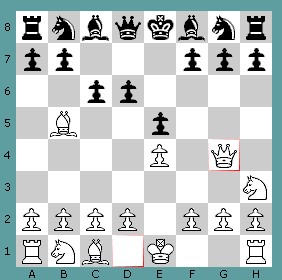
STANLEY RANDOM CHESS MONTHLY

The brilliant international grandmaster from South Korea, GM Kungpow, is a longstanding personal friend of mine. Sadly, his genius is little known, on account of the fact that he spends most of his life in a monastery. I'm pleased to present a brief biography of his life and interests.
GM Kungpow spends much of his time conducting historical research in reclusion in a strictly orthodox monastery. The monastery is in a secret location somewhere in South-East Asia, and is referred to by government officials sponsoring the research as the Bush Pilot Project. Kungpow specializes in Reformational and Counter-Reformational play, and his life's work is the publication of a collection of 95 separate studies, which contain his own theses for refuting the standard SR Chess openings and lines popular with the leading clergymen and ecclesiastical figures under the medieval papacy. His knowledge of sixteenth century Genevan Modal play is particularly outstanding. Consequently he has the distinguished honor of being the only international grandmaster with a perfect record in games that enter VH Conditions after the 30th move.
Also noteworthy is the fact that on his mother's side, Kungpow is a seventh generation descendant of the English Stanley family. His lineage has been traced to the immigrant Wendel Jefferson Stanley, who travelled to the Far East on the Spice Routes, but never returned to England after marrying a 16 year old girl by the name of Me Chi Lee, the daughter of a wealthy Korean soap collector. This branch of the Stanley family now specializes in manufacturing bicycle helmets in Taiwan, but at the time were leading figures in the production of hand carved Stanley Random Chess pieces. Kungpow's family ancestry also has connections to the Knights Templar, who were actively engaged under the auspices of a Secret Society for the Preservation of SR Chess during some of the darkest years of the Great SR Chess Purge.
Widely recognized for his diverse interests, GM Kungpow is also a leading contributer to an international team of researchers called Magnetic the Gathering, under the leadership of Dan Brown. The team is engaged in a project which uses principles of magnetism to decode all of Da Vinci's paintings, proving that in fact they are blueprints for Ancient Roman plumbing practices. In his spare time, Kungpow is known to enjoy his fascinating hobbies of bee-keeping, French knitting, and the translation of ancient Italian runes into Braille. He also has a longstanding interest in Russian ballet, and on more than one occasion made a guest performance as part of Tchaikovsky's Swan Lake.
In his early years, GM Kungpow studied under the traditional Eastern masters, which gives him a unique perspective on traditional play. Consequently he typically tends to flavor his analysis with profound Eastern philosophy and Zen-like sayings. His style is unlike that of any other international grandmaster, and while at times it may prove difficult to understand, it is always rewarding to study.
To illustrate his brilliance, I'll share with you the opening moves of a recent International Exhibition Game between GM Kungpow and yours truly, GM Topov. The exhibition game took a fascinating turn very early in the game, with GM Kungpow offering a brilliant Loose Madame, a gambit which had to be declined in order to avoid threats to Black's Royal Commode. Full game analysis is available elsewhere, but the following short summary of the opening (in PGN format) will give you some indication of GM Kungpow's genius:

|
| 4.Qg4! |
[Event "Stanley Random Chess International Exhibition Game"]
[Site "schemingmind.com"]
[White "GM Kungpow"]
[Black "GM Topov"]
1. Nh3 {Pacified Knight Opening, creating immediate modal opportunities for White}
1...e5 {Standard VonFinkelstein reply, with the central aggression needed for lateral shift in order to maintain tempo}
2. e4 {Silent Right Wing main-line of Pacified Knight Opening, providing temporal shelter to avoid post-knightal depression on h3}
2...d6 {The expected book move}
3. Bb5+ {A temporary distraction for Black}
3...c6 {The Pawned Pelican, conceding an open Royal Bedroom but corralling the knight on b8 with compensation in immobility}
4. Qg4 {Fawning an early Loose Madame, but threatening a Backwood's Threat with the Pacified Knight, and thus quite sound}
4...Qe7 {The Fawned Gambit Declined, or Counter-Reformational Two Step, to preserve the Royal Commode and future threats to f6. 4...Bxg4? is flawed after 5.Bxc6+ (with the Royal Commode indefensible by neighbouring pawns) because of 6.Nd7 (6.Nxc6?! gains material, but leaves the f6 square without sufficient defense once the light squares are unmoded), giving White the target on b7, and the Pacified Knight on h3 is poised to complete the Backwood's Threat after 7.d3!}
5. Ng5 {Sashimi Shiver Attack, a risky variation of Kodama's Call of Nature, and anticipating the Kona Defense}
5...Qd7 {Houblon de Lapin, declining the gambit and enforcing the conditions of the Phyrexian Paradox instead of opting for the Kona Defense}
6. Qf3 {Typical of Orange Mercantilism, with Dutch influence}
6...cxb5 {The defensive VanDyken Maneuver, with pressure on the c4 square in preparation for a later Double Header with the bishops}
SR Chess GM Gregory Topov
Posted Tuesday - 2006-04-04 - 12:07:25 EST
by Staff Reporter Verdra H. Ciretop in Toronto
All Rights Unreserved - Loof Lirpa Publishing
Text may be freely copied & redistributed